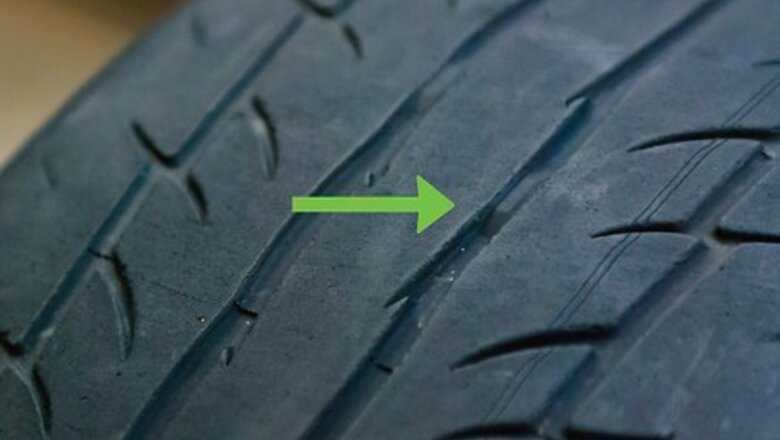
views
Examining Tread Integrity
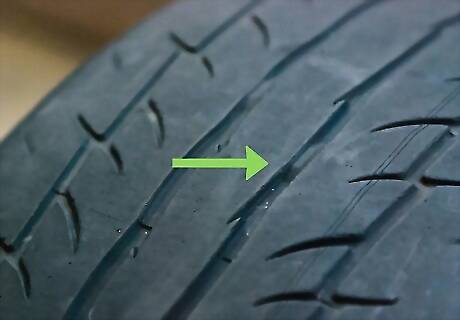
Replace your tires if the tread bar is flush with the tire tread. All tires sold in the U.S. and most other countries have tread wear bars—small horizontal bridges that form between your treads at a lower depth. As your tires wear, these bars become flush with the tread. When the tire tread is even with these wear bars, it means the tread is worn to ⁄32 inch (0.16 cm) and needs to be replaced immediately. When you look at your tire wear bars, be sure to look at the entire surface of the wheel and not just one isolated location.
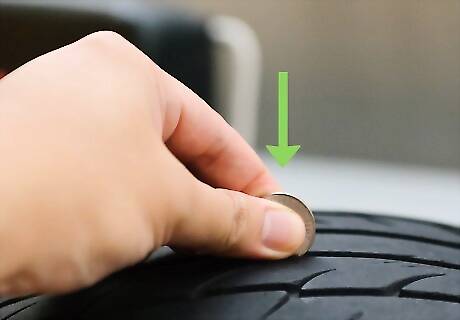
Check the wear of your tread quickly by inserting a Lincoln penny into it. Take a Lincoln penny and place it upside down with Lincoln facing you in the center of the tread at the thickest part of the tire. If you can see the very top of Lincoln's head or the copper above it, replace the tire immediately. If you cannot see the hair on the top of Lincoln's head—meaning the tire tread is at least as deep as his forehead—your tire does not need replacing yet. If you have a Canadian nickel, insert it between the tread with Queen Elizabeth's crown facing down. If the top of her crown is visible, the tire is below ⁄32 inch (0.16 cm) and needs to be replaced. Tires do not wear evenly, so be sure to insert the coin at several points from the outside to the inside of your tires. Tires generally wear more on the inside, but over-inflated tires will wear more in the middle. For a more accurate tread depth measurement, use a tread depth gauge.

Use a tread depth indicator for a more accurate measurement. Place the probe of the indicator in the center of one of the tire grooves on the outskirts of the tread. Remove the gauge by the barrel—taking care not to touch the probe—and note the tread depth. Continue this process for locations around the center tire grooves tire at least 15 inches (38 cm) apart and then average the numbers. Replace the tires if the depth is less than ⁄32 inch (0.16 cm). Repeat this process for the outer and inner circumferential grooves, and then average those numbers as well. To average numbers, divide the total by the number of individual measurements you made along the tread. Before using the tread depth indicator, push the tread depth gauge against a flat, hard surface and be sure it hits zero when it fully compresses. Don't place the tread gauge onto any of the raised surfaces or molded tread wear indicators.
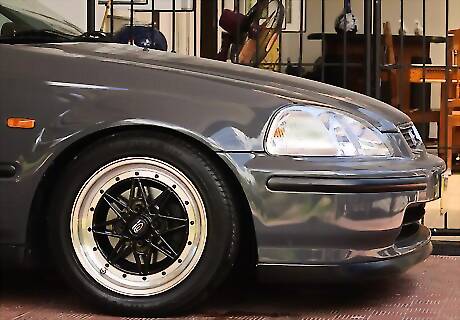
Check your state or region for tread recommendations. The primary function of tire tread is to divert water from beneath the tire to improve traction and avoid hydroplaning on wet roads. Once the tread is down to ⁄32 inch (0.16 cm), the tire is no longer safe and illegal in most areas of the world. Look at your state or region's tire tread requirements provided by the transportation department. Call or email your country's department of transportation or visit their website to locate tread laws. In some U.S. states, tires are considered to be legally worn out when they have decreased to ⁄16 inch (0.16 cm) of their remaining tread depth. In the U.K., the minimum depth for tire tread is 0.0456 inches (1.16 mm) across the central 3/4 of the tread around the whole tire.
Noticing Signs of Tire Damage
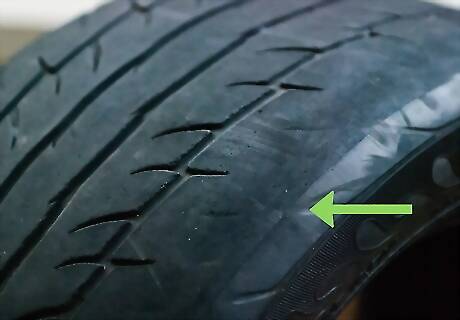
Bring your car in for maintenance if you notice irregular tread wear. This could indicate wheel misalignment, improper inflation pressure, the need for tire rotation, or all of the above. Regardless of the specific reason, uneven tread wear is a sign that you need to take your car in for servicing. If uneven tire wear is extreme or if tires wear out much faster than expected, have a competent tire workshop check your suspension and correct it as necessary before replacing tires. Improper alignment or worn suspension parts can dramatically shorten a tire's life. Rotate your tires from front to rear in pairs to avoid irregular tread wear. Take both front tires and move them to the rear and vice versa.

Check for any abnormal bulges or bubbles in the sidewall. The sidewall is the tire surface outside the rim that faces you when the car is parked. A bulge indicates that the rigid internal frame of the tire has been damaged and cracked, allowing air pressure to reach the flexible outer layers of the tire. Any tires with sidewall bulges should be replaced immediately, regardless of the tread status. Such damage could be caused by driving through a large pothole, driving over a curb, or by driving with low tire pressure. Never continue to drive on a tire that has a sidewall bulge. This indicates that the structural integrity of the tire has been significantly reduced, which greatly increases the likelihood of a sudden failure or blowout at highway speeds.

Balance your tires if you feel steering wheel vibration. If your tires are worn unevenly, you may feel a vibration in the steering wheel when you are driving. If the vibration starts at 40 to 50 mph (64.37 to 80.47 km/h) and intensifies as you increase your speed, you probably need to balance your tires. If that doesn't stop the vibration, the tire is most likely damaged and needs a full replacement. If you experience vibrations in the absence of tread damage, try balancing and aligning your tires' shock absorbers. If you notice tire vibrations along with other tire damage indicators like abnormal bulges and irregular tread wear, you probably have to replace your tire. If you notice that your tires are cupped—meaning they have a cupped or scalloped appearance around the tire—they likely aren't being rotated enough. EXPERT TIP Hovig Manouchekian Hovig Manouchekian Auto Repair & Design Specialist Hovig Manouchekian is an Auto Repair and Design Specialist and the Manager of Funk Brothers Auto, a family-owned business operated since 1925. With over 30 years of experience in the automotive industry, Hovig specializes in the process of auto repair and maintenance. He is also very knowledgeable in common automotive issues and needs including engine repair, battery replacement, and windshield accessory and maintenance. Hovig's knowledge and hard work have contributed to Funk Brothers Auto winning Angie's List Super Service Award for five consecutive years. Hovig Manouchekian Hovig Manouchekian Auto Repair & Design Specialist Your steering wheel shaking could indicate an issue. There are several reasons why your steering wheel might be shaking. Common causes include uneven tire wear, warped brake rotors, or worn suspension components. Additionally, misaligned wheels can contribute to shaking. In severe cases, a bent axle could also be the issue.
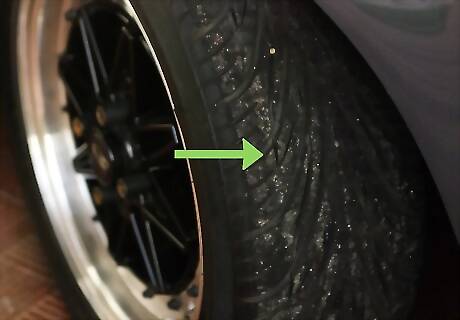
Check for dry rot and have affected tires inspected or replaced. If you see little cracks all over your tires, it means that the rubber is breaking down. Tires with dry rot can fall apart and separate from the steel belt, which causes damage to the exterior of the car. In some cases, your wheels might start rotting before the tread starts to diminish—you should still bring them in to be inspected or replaced. Inspect for dry rot before heading out on any longer trips and bring your car in for a check-up regularly. Degrease your tires to prevent dry rot, especially if your tires are exposed to a high degree of sunlight.
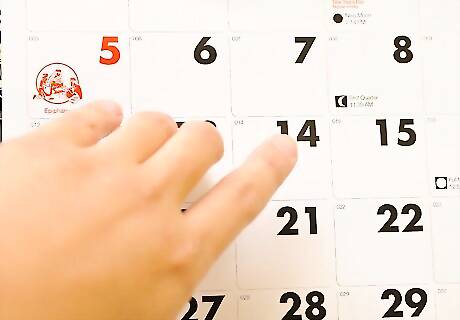
Replace your tires at least every 6 years. Check the 4-digit code on the wall of the tire for its age. Regardless of your country, most governmental transportation departments place 4-digit numbers on the wall of each tire. The first 2 numbers represent the week it was made and the last 2 represent the year. For example, 12/08 means your tire was made in the 12th week of 2008. If the tire is more than 6 years old, replace it. If you're having trouble finding the number, look for the initials DOT, followed by other letters and numbers. The code should appear following dot and will not contain any letters. Remember that although 10 years is the maximum service life for tires—which means since the date they were manufactured—this should never be used as the maximum drive time. Always err on the side of caution if you suspect your vehicle has tires that are over 6 years of age. Always change your tires if the tread is below the minimum depth recommendation, which is often ⁄32 inch (0.16 cm).

















Comments
0 comment